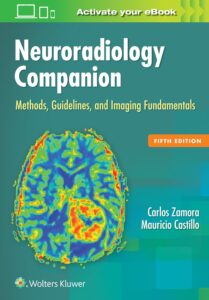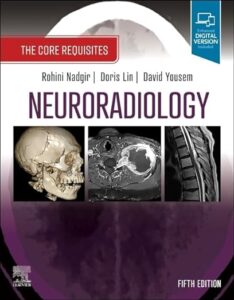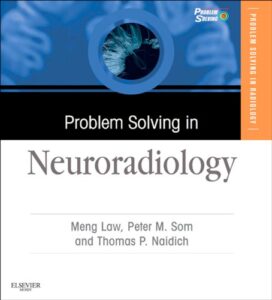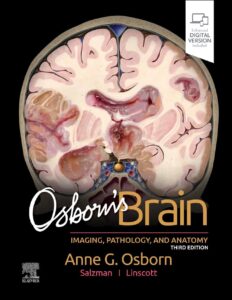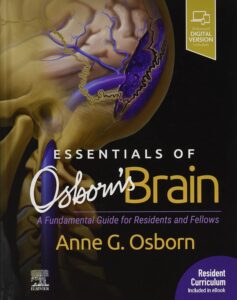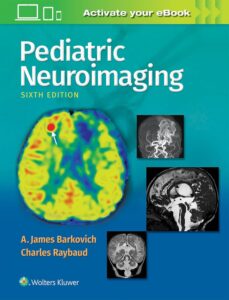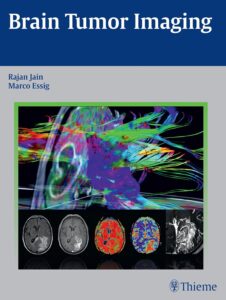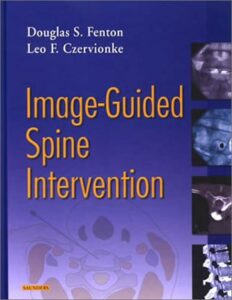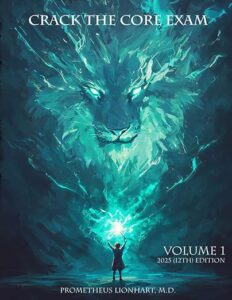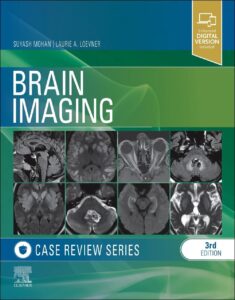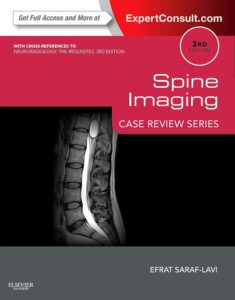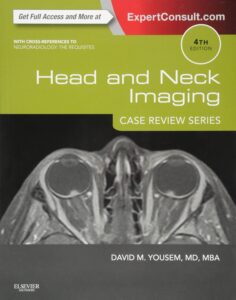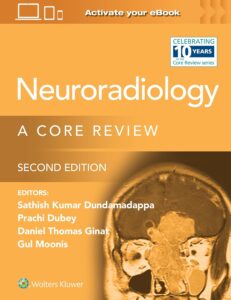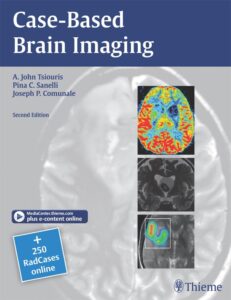Books
A question that frequently comes up is, “What are the best neuroradiology textbooks?” While the number of online resources for learning radiology have expanded over the years, books are still a key part of the educational process. Sometimes, there is nothing better than having a paper copy of a book to glance through, especially after a day of eye fatigue from staring at a screen. This is a starter list of some books that might be useful to people interested in neuroradiology, ranging from those who see patients with neuroradiology scans to those who are practicing neuroradiology at a high level, such as a CAQ certified subspecialist.
Because time is hard to come by, it’s hard to decide where to focus your efforts on a given book. I recommend deciding on the level of detail you are interested in and whether you want a general book or focus on a specific topic, such as spine or brain tumors. While not comprehensive, this is a list of some of the resources I believe are worth checking out.
Books are sorted by topic, with comments regarding what level individual (e.g. medical student, resident, faculty) may benefit most from them.
*disclaimer: links on this page are Amazon affiliate links. I get a small referral fee which helps fund this site if you purchase through these links.
General neuroradiology
There are a couple of key books for general neuroradiology I would recommend. They vary in time commitment, and sometimes it may be useful to read only portions.
Neuroradiology Companion – Carlos Zamora, Mauricio Castillo
Target audience: medical students, junior residents
Detail level: low
This is one of the first books on neuroradiology that I ever read (although it was an earlier edition). At the beginning, it has a nice section overviewing some general techniques in neuroradiology, such as how the scans are performed and what type of imaging you might perform for a given condition. Then, it goes into a case-based review of some of the most common conditions divided by body system. It shows you some key images along with short but relevant bullet points. This is a nice and somewhat short book which could be read over the course of a 2-4 week neuroradiology rotation. Great for medical students and junior residents on their first rotation.
Neuroradiology Requisites – Rohini Nadgir, Doris Lin, David Yousem
Target audience: medical students, junior residents, senior residents, fellows
Detail level: medium
This book is targeted to residents and fellows, but may be useful to fellows as well. It’s goal is to be thorough and cover most of the major neuroradiology topics, including brain, spine, and head/neck. There is a lot of detail there, and it’s longer than you would read on a typical rotation for a medical student or resident. Sections are organized by pathology. Medical students might try borrow the book from a resident or faculty for a few weeks. Don’t get too bogged down in the text on the first pass and consider just going through and looking at the images while reading the captions. Then on the second pass you can dig into the topics in more detail.
Problem Solving in Neuroradiology – Meng Law, Peter Som, Thomas Naidich
Target audience: senior residents, fellows, faculty
Detail level: medium
I actually really like this book. I’m sad to learn that the print edition appears to be out of print and doesn’t seem like it’s going to be updated. For that reason, I’m linking to the electronic edition here. It’s a very approachable, nuts and bolts sort of way of approaching neuroradiology. Several chapters at the beginning are devoted to modalities such as advanced MRI and PET/CT. The majority of the book is devoted to a disease category based approach to the explanations. It’s very easy to sit down and read a relevant section, and the level is appropriate for a senior resident through a faculty who wants a nice focused review. My only complaint is that there is some repetitiveness between chapters (especially if you were reading straight through), but it’s less of a problem because the format of the book is more suitable to targeted reading of one chapter at a time based on level of interest. This is a nice book for fellows.
Osborn’s Brain – Anne Osborn, Gary Hedlund, Karen Salzman
Target audience: senior residents, fellows, faculty
Detail level: high
This is a high-level book which provides a lot of detail about imaging of the brain in almost all of its areas. While there are some portions which can be useful to the junior trainee, it’s simply too detailed and too long to recommend to medical students and junior residents too frequently. That said, it’s extremely readable, thorough, and considered the standard for imaging of the brain. It’s a go-to book that I often return to, and any fellow or faculty will want to have this on their bookshelf. The book also comes with electronic access, which is nice as a reference.
Essentials of Osborn’s Brain – Anne Osborn
Target audience: senior residents, fellows, faculty
Detail level: medium
This is a revised version of Osborn’s high-level book which is more abbreviated for the junior trainee. This probably makes it more appropriate for the student or resident level with a little bit less detail. Given the lower price and the fact that most residents won’t need all that detail, it’s probably a good starting place for most residents and even some fellows. If you want more detail, then you can go for the full book.
Subspecialty neuroradiology
There are any number of books on subspecialty topics within neuroradiology, including pediatric imaging, head & neck imaging, and spine. Here are a couple of books that I recommend. Most of these are not geared towards new trainees but rather fellows and faculty.
Pediatric Neuroimaging – James Barkovich, Charles Raybaud
Target audience: fellows, faculty
Detail level: high
This is the quintessential reference book in pediatric neuroradiology, written by one of the founding fathers of pediatric neuroradiology as a subspecialty, Jim Barkovich. This book is very detailed and an excellent reference for pediatric imaging. Only the truly hardcore will sit down with this book and read from start to finish, but it has excellent and updated coverage of most of the major pediatric imaging topics today.
Brain Tumor Imaging – Rajan Jain, Marco Essig
Target audience: fellows, faculty
Detail level: medium-high
This is a pretty good book that covers the entire scope of brain tumor imaging pretty well, including the use of advanced imaging such as spectroscopy and perfusion. A lot of the content covered could be obtained from reading a bunch of review papers, but it’s nice to have it all in one spot. A fellow with specialized interest in brain tumor imaging or neuroradiology faculty would find this book useful. It’s also very readable and pretty approachable given the density of the topic.
Image-Guided Spine Intervention – Douglas Fenton and Leo Czervionke
Target audience: senior residents, fellows, faculty
Detail level: medium
There is one very good book on neuroradiology procedures that is somewhat difficult to find, as it is not in wide print and was published in 2002. However, it has nice coverage of some more advanced procedures (primarily pain procedures) as well as some basics, such as needle guidance techniques. If you can get a copy, it’s definitely worthwhile. Any resident/fellow interested in learning procedures, including pain procedures, would enjoy this book. The first chapter covers some great basics of procedures, but it’s probably not worth getting just for that.
Board review
There are many books dedicated to review for the ABR core,certifying, and CAQ examinations. Separate pages on this site discuss the strategies for these exams in greater detail. These are some of the books that may be useful preparing for those exams. They also are really nice case review books which can supplement more general reading and studying during rotations. To be honest, I’ve spent more time in my career reading these books than some of the more detailed books above.
Crack the Core Exam ( Volume 1 and Volume 2) – Prometheus Lionheart
Target audience: junior residents, senior residents
Detail level: medium
These continue to be updated on an annual basis, now on the 12th edition (2025) They are the standard for examination preparation as part of the new ABR process and almost all residents are or should be using them. Years ago, these books replaced several old-fashioned standards, including Radiology Review Manual (Dahnert) and Primer of Diagnostic Imaging/Purple Book (Weissleder), which aren’t really up to modern standards. What more do you need to know, other than that this book is so good it’s been rumored to make the ABR change the exam so the answers aren’t so obvious from studying this book.
Neuroradiology is covered in Chapter 11, at the beginning of volume 2. The style is straightforward text which is readable and supplemented by simple and effective schematics. These books are highly recommended, and it’s probably best to use them early in your residency so you know the material backwards and forwards before the exam. Plus, I LOVE THAT THEY ARE UPDATED EVERY YEAR! THANK YOU PROMETHEUS!
There is also a Crack the Core Case Review book which you may also find useful.
Brain Imaging: Case Review Series – Laurie Loevner
Target audience: junior residents, senior residents, fellows
Detail level: medium
This is probably the best of the case review series books. These were my personal favorites when I was a resident and I continue to recommend them. The presentation is case style and divided into easy (“Opening Round”), moderate (“Fair Game”), and hard (“Challenge”) sections. Residents taking the core and certifying exams should be extremely comfortable with the easy-moderate sections and have a reasonable understanding of the hard section. It’s pretty readable and easy to parse through in a week or so while preparing for the exam. Much like Crack the Core, it’s probably best to get familiar with these books early. The brain is the best of the series and covers
Spine Imaging: Case Review Series – Efrat Saraf-Lavi
Target audience: junior residents, senior residents, fellows
Detail level: medium
This is another in the popular case review series books. Like the brain book, the presentation is case style and divided into easy (“Opening Round”), moderate (“Fair Game”), and hard (“Challenge”) sections. Unfortunately, this book is not quite as high yield as the brain book. There is some repetitiveness to the diagnoses and the images are a little bit lower quality, although part of this is just because it’s hard to capture spine imaging in only a few images. This book remains useful because there aren’t that many other spine neuroradiology review books and it give you a nice case based review to peruse before the exam.
Head and Neck Imaging: Case Review Series – David Yousem
Target audience: senior residents, fellows
Detail level: medium
This is probably the weakest of the Case Review Series books for neuroradiology. Not that it’s particularly bad, but it’s pretty low yield for all the exams except for maybe the CAQ exam. The presentation maintains the division between easy (“Opening Round”), moderate (“Fair Game”), and hard (“Challenge”) sections. Like the spine book, this book is not quite as high yield as the brain book and is probably the lowest yield of all the books, simply because there isn’t that much head and neck imaging on these exams. At most 3-5 questions would come from this book. I think this book is most useful for senior residents or fellows interested in neuroradiology who want to test their head/neck knowledge. Nice for a quick review though.
Neuroradiology: A Core Review – Prachi Dubey et al.
Target audience: junior residents, senior residents, fellows
Detail level: medium
This is a nice book, similar in format to the Case Review Series. Each case is presented with a few images and a couple of relevant questions to simulate the ABR exams. Then the answers to the questions are found at the end. Compared to the Case Review Series, the image quality is a little higher and the case distribution is similar. I found it a little inconvenient to flip back and forth to the answer section in this book because all the cases on a given topic are presented consecutively followed by all the answers at the end. However, this does simulate the exam a little better. A major plus of this book is that it covers Brain, Spine, and Head & Neck in one volume, essentially replacing 3 volumes of similar cost with CRS. I think this is a suitable alternative to Case Review Series if you want it. For me, this was a supplement when I was studying for the certifying exam/CAQ because I was already familiar with the CRS books.
Case Based Brain Imaging (RadCases) – Tsiouris et al.
Target audience: junior residents, senior residents, fellows
Detail level: medium
Like the other books above, this is a case-based review book that covers imaging of the brain. It has a relatively straightforward presentation, good quality images, and a good format that you can review quickly before the exams. My first preference is the case review series book above, but I think this is a nice substitute or supplement if you want more cases. The Case Review Series: Brain book is getting a little bit older so it will be nice when they refresh it in 2023. This book is also set for a refresh in December 2023.
Complete book list
If you just want to cut to the chase, I have compiled a list of books at Amazon where you can just see immediately what you are interested in.
Neuroradiology book list at Amazon
Click to check out the list of books recommended by the site compiled at the world’s largest bookseller, Amazon.com.
This list was updated on 04/28/2024 to include new versions of Crack the Core books and remove Amazon sitestripe images.

